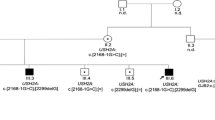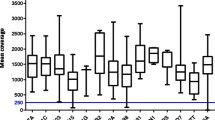Abstract
Usher syndrome (USH) is inherited in an autosomal recessive mode. The disease is characterized by hearing loss, progressing vision loss, and vestibular dysfunction. In most cases, it is the reason for deafness and blindness in school-age children. The prevalence of USH in the main population is estimated as 4.4 per 100000 individuals, approximately. The prevalence of heterozygous carriers can reach 1 per 70 normally hearing individuals. There is currently no effective treatment of USH. The patients are provided with hearing aids, but, in case of severe hearing impairement these aids give no effect. In view of this, developing diagnostic methods is important. It is believed that molecular genetic investigations will enable early diagnostics of the syndrome.
Similar content being viewed by others
References
Fortnum, H.M., Marshall, D.H., and Summerfield, A.Q., Epidemiology of the UK Population of Hearing-Impaired Children, Including Characteristics of Those with and without Cochlear Implants—Audiology, Aetiology, Comorbidity and Affluence, Int. J. Audiol., 2002, no. 41, pp. 170–179.
Marazita, M.L., Ploughman, L.M., Rawlings, B., et al., Genetic Epidemiological Studies of Early-Onset Deafness in the US School-Age Population, Am. J. Med. Genet., 1993, vol. 46, no. (5), pp. 486–491.
Haim, M., Prevalence of Retinitis Pigmentosa and Allied Disorders in Denmark: II. Systemic Involvement and Age at Onset, Acta Ophthalmol. (Copenhagen), 1992, no. 70, pp. 417–426.
Boughman, J.A., Vernon, M., and Shaver, K.A., Usher Syndrome: Definition and Estimate of Prevalence from Two High-Risk Populations, J. Chronic. Dis., 1983, no. 36, pp. 595–603.
Moller, C.G., Kimberling, W.J., Davenport, S.L., et al., Usher Syndrome: An Otoneurologic Study, Laryngoscope, 1989, no. 99, pp. 73–79.
Rosenberg, T., Haim, M., Hauch, A.M., et al., The Prevalence of Usher Syndrome and Other Retinal Dystrophy-Hearing Impairment Associations, Clin. Genet., 1997, no. 51, pp. 314–321.
Spandau, U.H. and Rohrschneider, K., Prevalence and Geographical Distribution of Usher Syndrome in Germany, Graefes Arch. Clin. Exp. Ophthalmol., 2002, no. 240, pp. 495–498.
Pennings, R., Changing Horizons for People with Usher in the 21st Century: Clinical and Genetic Research in Usher Syndrome, in Genetic Research in Usher Syndrome, 2005, no. 2, pp. 17–21.
Markova, T.G., Nekrasova, N.V., Shagina, I.A., et al., Genetic Screening among the Children with Early Congenital Hearing Loss, Vestn. Otorinolaringol., 2006, no. 4, pp. 9–14.
Ahmed, Z.M., Riazuddin, S., and Wilcox, E.R., The Molecular Genetics of Usher Syndrome, Clin. Genet., 2003, no. 63, pp. 431–444.
Cremers, F.P.M., Kimberling, W.J., and Kulm, M., Development of a Genotyping Microarray for Usher Syndrome, J. Med. Genet., 2007, no. 44, pp. 153–160.
Kaplan, J., Gerber, S., Bonneau, D., et al., A Gene for Usher Syndrome Type I (USH1A) Maps to Chromosome 14q, Genomics, 1992, no. 14, pp. 979–987.
Kimberling, W.J., Moller, C.G., Davenport, S., et al., Linkage of Usher Syndrome Type I Gene (USH1B) to the Long Arm of Chromosome 11, Genomics, 1992, no. 14, pp. 988–994.
Astuto, L.M., Weston, M.D., Carney, C.A., et al., Genetic Heterogeneity of Usher Syndrome: Analysis of 151 Families with Usher Type I, Am. J. Hum. Genet., 2000, no. 67, pp. 1569–1574.
Gibson, F., Walsh, J., Mburu, P., et al., A Type VII Myosin Encoded by the Mouse Deafness Gene shaker-1, Nature, 1995, no. 374, pp. 62–64.
Liu, X.Z., Newton, V.E., Steel, K.P., et al., Identification of a New Mutation of the Myosin VII Head Region in Usher Syndrome Type 1, Hum. Mutat., 1997, no. 10, pp. 168–170.
Johnson, K.R., Gagnon, L.H., Webb, L.S., et al., Mouse Models of USH1C and DFNB18: Phenotypic and Molecular Analyses of Two New Spontaneous Mutations of the Ush1c Gene, Hum. Mol. Genet., 2003, no. 30, pp. 3075–3086.
Wayne, S., Der Kaloustian V.M., Schloss M., et al. Localization of the Usher Syndrome Type 1D Gene (Ush1D) to Chromosome 10, Hum. Mol. Genet., 1996, no. 5, pp. 1689–1692.
Di Palma, F., Holme, R.H., Bryda, E.C., et al., Mutations in Cdh23, Encoding a New Type of Cadherin, Cause Stereocilia Disorganization in Waltzer, the Mouse Model for Usher Syndrome Type 1D, Nat. Genet., 2001, no. 27, pp. 103–107.
Chaib, H., Kaplan, J., Gerber, S., et al., A Newly Identified Locus for Usher Syndrome Type I, USH1E, Maps to Chromosome 21q21, Hum. Mol. Genet., 1997, no. 6, pp. 27–31.
Wayne, S., Lowry, R.B., McLeod, D.R., et al., Localization of the Usher Syndrome Type 1F (Ush1F) to Chromosome 10, Am. J. Hum. Genet., 1997, no. 61, pp. 27–31.
Hereditary Hearing Loss Homepage: http://dnalabwww. uia.ac.be/dnalab/hhh
Alagramam, K.N., Murcia, C.L., Kwon, H.Y., et al., The Mouse Ames Waltzer Hearing-Loss Mutant Is Caused by Mutation of Pcdh15, a Novel Protocadherin Gene, Nat. Genet., 2001, no. 7, pp. 99–102.
Mustapha, M., Chouery, E., Torchard-Pagnez, D., et al., A Novel Locus for Usher Syndrome Type I, USH1G, Maps to Chromosome 17q24-25, Hum. Genet., 2002, no. 110, pp. 348–350.
Kimberling, W.J., Weston, M.D., Moller, C., et al., Localization of Usher Syndrome Type II to Chromosome 1q, Genomics, 1990, no. 7, pp. 245–249.
Weston, M.D., Eudy, J.D., Fujita, S., et al., Genomic Structure and Identification of Novel Mutations in usherin, the Gene Responsible for Usher Syndrome Type IIa, Am. J. Hum. Genet., 2000, no. 66, pp. 1199–1210.
Hmani, M., Ghorbel, A., Boulila-Elgaied, A., et al., A Novel Locus for Usher Syndrome Type II, USH2B, Maps to Chromosome 3 at P23-24.2, Eur. J. Hum. Genet., 1999, no. 7, pp. 363–367.
Fukushima, K., Ramesh, A., Srisailapathy, C.R., et al., An Autosomal Recessive Nonsyndromic Form of Sensorineural Hearing Loss Maps to 3p-DFNB6, Genome Res., 1995, no. 5, pp. 305–308.
Pieke-Dahl, S., Moller, C.G., Kelley, P.M., et al., Genetic Heterogeneity of Usher Syndrome Type II: Localization to Chromosome 5q, J. Med. Genet., 2000, no. 37, pp. 256–262.
Kaplan, J., Gerber, S., Bonneau, D., et al., Usher Syndrome Type 1a: From Myth to Reality, Invest. Ophthalmol. Vis. Sci., 2006, no. 47, p. 4605.
Gerber, S., Bonneau, D., Gilbert, B., et al., USH1A: Chronicle of a Slow Death, Am. J. Hum. Genet., 2006, no. 78(2), pp. 357–359.
Liu, X.Z., Walsh, J., Mburu, P., et al., Mutations in the Myosin VIIA Gene Cause Non-Syndromic Recessive Deafness, Nat. Genet., 1997, no. 16, pp. 188–190.
Weil, D., Kussel, P., Blanchard, S., et al., The Autosomal Recessive Isolated Deafness, DFNB2, and the Usher 1B Syndrome Are Allelic Defects of the Myosin VIIA Gene, Nat. Genet., 1997, no. 16, pp. 191–193.
Adato, A., Weil, D., Kalinski, H., et al., Mutation Profile of All 49 Exons of the Human Myosin VIIA Gene, and Haplotype Analysis, in Usher 1B Families from Diverse Origins, Am. J. Hum. Genet., 1997, no. 61, pp. 813–821.
Chen, Z.Y., Hasson, T., Kelley, P.M., et al., Molecular Cloning and Domain Structure of Human Myosin-VIIa, the Gene Product Defective in Usher Syndrome 1B, Genomics, 1996, no. 36, pp. 440–448.
Mermall, V., Post, P.L., and Mooseker, M.S., Unconventional Myosins in Cell Movement, Membrane Traffic, and Signal Transduction, Science, 1998, no. 279, pp. 527–533.
Eudy, J.D. and Sumegi, J., Molecular Genetics of Usher Syndrome, Cell. Mol. Life Sci., 1999, no. 56, pp. 258–267.
Weston, M.D., Kelley, P.M., Overbeck, L.D., et al., Myosin VIIA Mutation Screening in 189 Usher Syndrome Type 1 Patients, Am. J. Hum. Genet., 1996, no. 59, pp. 1074–1083.
Bitner-Glindzicz, M., Lindley, K.J., Rutland, P., et al., A Recessive Contiguous Gene Deletion Causing Infantile Hyperinsulinism, Enteropathy and Deafness Identifies the Usher Type 1C Gene, Nat. Genet., 2000, no. 26, pp. 56–60.
Verpy, E., Leibovici, M., Zwaenepoel, I., et al., A Defect in Harmonin, a PDZ Domain-Containing Protein Expressed in the Inner Ear Sensory Hair Cells, Underlies Usher Syndrome Type 1C, Nat. Genet., 2000, no. 26, pp. 51–55.
Fanning, A.S. and Anderson, J.M., PDZ Domains: Fundamental Building Blocks in the Organization of Protein Complexes at the Plasma Membrane, J. Clin. Invest., 1999, no. 103, pp. 767–772.
Ahmed, Z.M., Smith, T.N., Riazuddin, S., et al., Nonsyndromic Recessive Deafness DFNB18 and Usher Syndrome Type 1C Are Allelic Mutations of USH1C, Hum. Genet., 2002, no. 110, pp. 527–531.
Zwaenepoel, I., Verpy, E., Blanchard, S., et al., Identification of Three Novel Mutations in the USH1C Gene and Detection of Thirty-One Polymorphisms Used for Haplotype Analysis, Hum. Mutat., 2001, no. 17, pp. 34–41.
Bork, J.M., Peters, L.M., Riazuddin, S., et al., Usher Syndrome 1D and Nonsyndromic Autosomal Recessive Deafness DFNB12 Are Caused by Allelic Mutations of the Novel Cadherin-Like Gene CDH23, Am. J. Hum. Genet., 2001, no. 68, pp. 26–37.
Boggon, T.J., Murray, J., Chappuis-Flament, S., et al., CCadherin Ectodomain Structure and Implications for Cell Adhesion Mechanisms, Science, 2002, no. 296, pp. 1308–1313.
Astuto, L.M., Bork, J.M., Weston, M.D., et al., CDH23 Mutation and Phenotype Heterogeneity: A Profile of 107 Diverse Families with Usher Syndrome and Nonsyndromic Deafness, Am. J. Hum. Genet., 2002, no. 71, pp. 262–275.
Alagramam, K.N., Yuan, H., Kuehn, M.H., et al., Mutations in the Novel Protocadherin PCDH15 Cause Usher Syndrome Type 1F, Hum. Mol. Genet., 2001, no. 10, pp. 1709–1718.
Weil, D., El-Amraoui, A., Masmoudi, S., et al., Usher Syndrome Type 1G (USH1G) Is Caused by Mutations in the Gene Encoding SANS, a Protein That Associates with the USH1C Protein, Harmonin, Hum. Mol. Genet., 2003, no. 12, pp. 463–471.
Petit, C., Usher Syndrome: From Genetics to Pathogenesis, Annu. Rev. Genomics Hum. Genet., 2001, no. 2, pp. 271–297.
Adato, A., Michel, V., and Kikkawa, Y., Interactions in the Network of Usher Syndrome Type 1 Proteins, Hum. Mol. Genet., 2005, no. 14(3), pp. 347–356.
Eudy, J.D., Weston, M.D., Yao, S., et al., Mutation of a Gene Encoding a Protein with Extracellular Matrix Motifs in Usher Syndrome Type IIa, Science, 1998, no. 280, pp. 1753–1757.
Ouyang, X.M., Yam, D., Hejtmancik, J.F., et al., Mutational Spectrum in Usher Syndrome Type II, Clin. Genet., 2004, no. 65, pp. 288–293.
Aller, E., Jaijo, T., and Beneyto, M., Identification of 14 Novel Mutations in the Long Isoform of USH2A in Spanish Patients with Usher Syndrome Type II, J. Med. Genet., 2006, no. 43, p. 55.
McMillan, D.R., Kayes-Wandover, K.M., and Richardson, J.A., Very Large G Protein-Coupled Receptor-1, the Largest Known Cell Surface Protein, Is Highly Expressed in the Developing Central Nervous System, J. Biol. Chem., 2002, no. 277, pp. 785–792.
McGee, J., Goodyear, R.J., McMillan, D.R., et al., The Very Large G-Protein-Coupled Receptor VLGR1: A Component of the Ankle Link Complex Required for the Normal Development of Auditory Hair Bundles, J. Neurosci., 2006, no. 26, pp. 6543–6553.
Kremer, H., van Wijk, E., Marker, T., et al., Usher Syndrome: Molecular Links of Pathogenesis, Proteins and Pathways, Hum. Mol. Genet., 2006, no. 15, pp. 262–270.
Reiners, J., van Wijk, E., Marker, T., et al., Scaffold Protein Harmonin (USH1C) Provides Molecular Links between Usher Syndrome Type 1 and Type 2, Hum. Mol. Genet., 2005, no. 14, pp. 3933–3943.
Joensuu, T., Hamalainen, R., Yuan, B., et al., Mutations in a Novel Gene with Transmembrane Domains Underlie Usher Syndrome Type 3, Am. J. Hum. Genet., 2001, no. 69, pp. 673–684.
Sankila, E.M., Pakarinen, L., Kaariainen, H., et al., Assignment of an Usher Syndrome Type III (USH3) Gene to Chromosome 3q, Hum. Mol. Genet., 1995, no. 4, pp. 93–98.
Adato, A., Vreugde, S., Joensuu, T., et al., USH3A Transcripts Encode Clarin-1, a Four-Transmembrane-Domain Protein with a Possible Role in Sensory Synapses, Eur. J. Hum. Genet., 2002, no. 10, pp. 339–350.
Fields, R.R., Zhou, G., Huang, D., et al., Usher Syndrome Type III: Revised Genomic Structure of the USH3 Gene and Identification of Novel Mutations, Am. J. Hum. Genet., 2002, no. 71, pp. 607–617.
Author information
Authors and Affiliations
Corresponding author
Additional information
Original Russian Text © A.M. Tazetdinov, L.U. Dzehemileva, E.K. Khusnutdinova, 2008, published in Genetika, 2008, Vol. 44, No. 6, pp. 725–733.
Rights and permissions
About this article
Cite this article
Tazetdinov, A.M., Dzehemileva, L.U. & Khusnutdinova, E.K. Molecular genetics of usher syndrome. Russ J Genet 44, 627–634 (2008). https://doi.org/10.1134/S102279540806001X
Received:
Accepted:
Published:
Issue Date:
DOI: https://doi.org/10.1134/S102279540806001X




